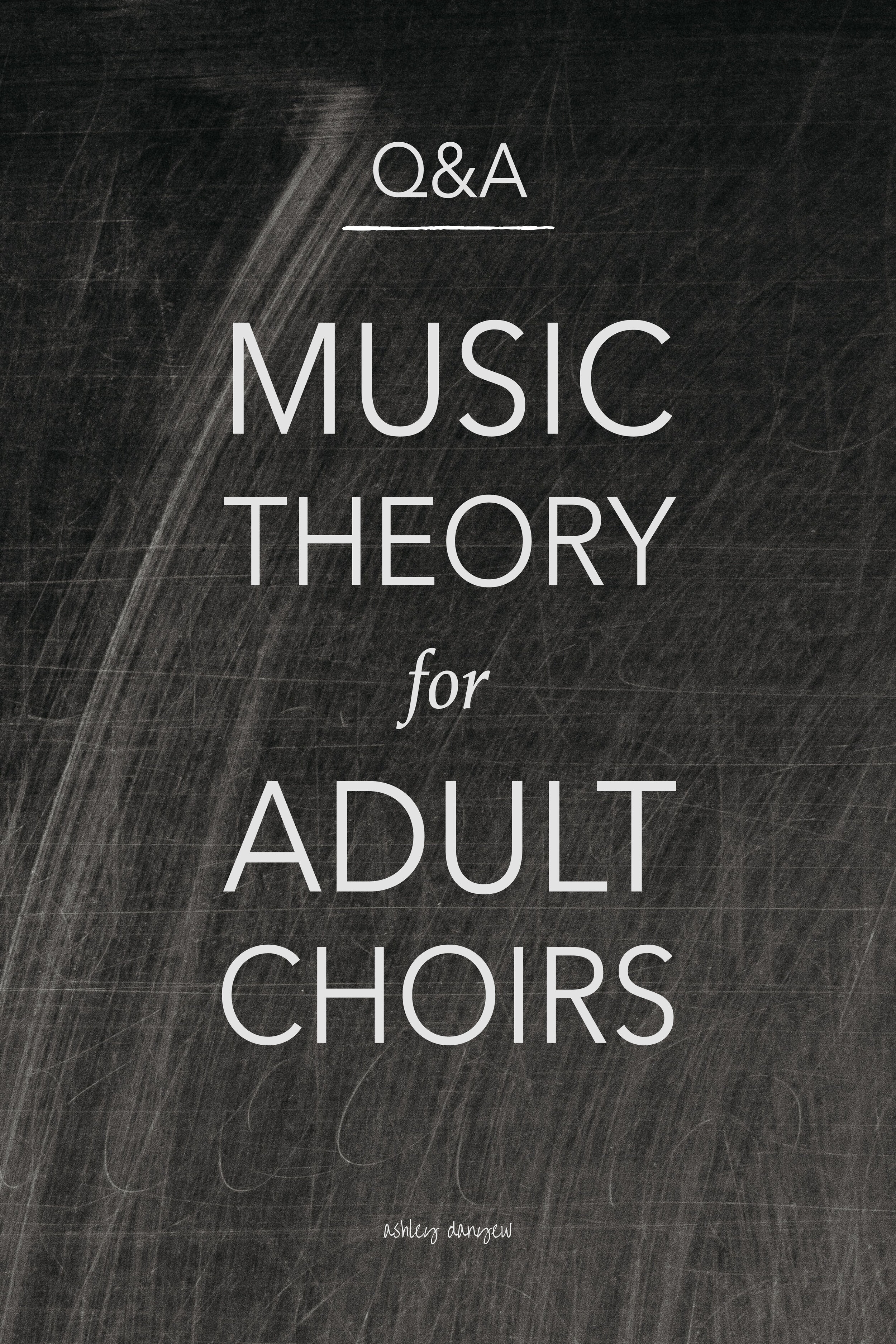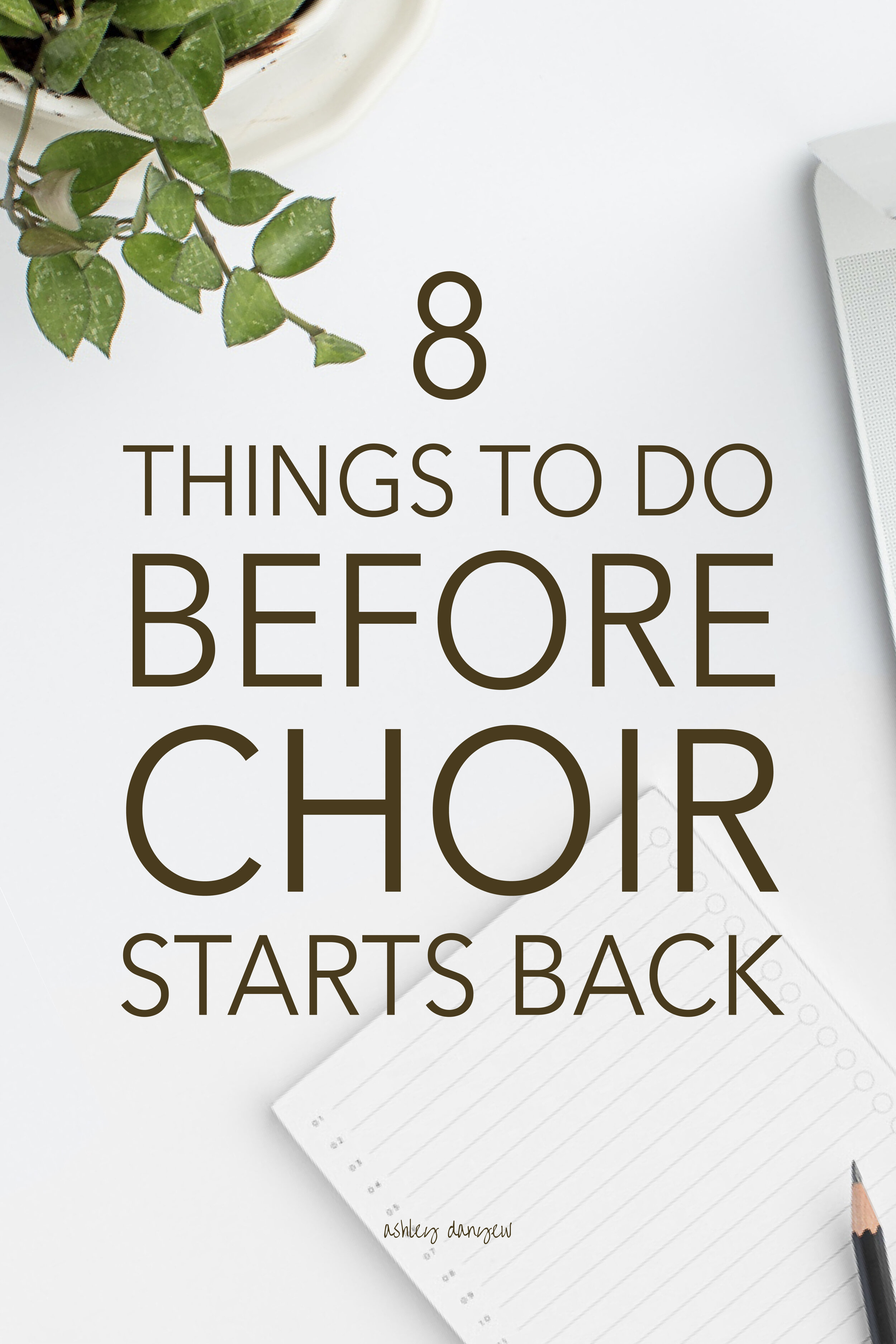It’s back-to-school season, which means it’s time for all things Fall, new school supplies, and the start of a new choir year.
If you’re a planner, like me, and you like things to be organized, you probably spent some time this summer cleaning out choir folders and boxes, straightening up counters and rearranging chairs, getting the piano tuned, and planning music for the Fall and Christmas. You may have even spruced up your choir room a bit, with a new bulletin board, fresh whiteboard markers, and a blank calendar.
What’s missing?
Well, whether you’re working with an adult choir, a youth choir, or a children’s choir, there are a few things every choir room (and rehearsal) should have. Here’s my must-have list, from A to Z:
A to Z: Must-Haves for Your Choir Room and Rehearsals
A is for art.
This might be a photograph, an inspirational quote, or a music-inspired painting - something to help make your choir room a welcoming, hospitable place.
B is for bulletin board.
If you don’t already have one, buy a bulletin board (or repurpose one from somewhere else in the church) to hang on one wall. Even a small bulletin board can hold things like a sign-out calendar (so you know who’s out of town when), a list of upcoming anthems, an inspirational quote or photo, and a few pertinent announcements.
B is also for boxes - one for each choir member - to hold things like their folder and music, an extra pencil, and a pack of tissues, if needed.
C is for clock.
Timeliness is everything! Make sure to always start and end your rehearsals on time. This communicates respect to your choir members and lets them know that you value their time.
Hang a clock on the back wall, so you can see it as you rehearse and consider hanging one on the front wall, too, so everyone can make sure to be in their seats, ready to sing at the start of rehearsal. 😃
D is for devotional.
What makes church choir different from a community choir? The spiritual aspect. Yes, it is a social gathering and hopefully, it's a rewarding musical experience, but it's also an opportunity to grow in faith and fellowship with one another.
Keep a small book of devotions on your desk or on a shelf near the front of the room. Mark your favorites in advance so you can quickly pull it out during rehearsal and find your place. Choose a devotion to do each week (or every other week) that ties in with something you’re singing.
E is for encouragement.
A big part of your job as choir director is to be a cheerleader. Make sure to encourage your singers regularly, remind them you are grateful for their dedication, talents, and service. Send out notes of encouragement (via email) to build them up and help them feel confident in their ability to contribute.
F is for folders.
Simple black choir folders with elastic bands inside are lightweight and easy to hold. Make sure you have one for each choir member, plus several extras, in case a new person shows up to rehearsal, one wears out, or one gets misplaced.
F is also for folder/robe list - a place to keep track of everyone’s folder and robe numbers. Post one by the robe closet and one next to the folder boxes.
G is for grace.
Sometimes, singers don’t show up on time. Sometimes, they forget to turn in their music. Sometimes, they stop showing up after Easter. It happens. It’s important in ministry to show grace to those we serve with. Remember, they are volunteers. And sometimes, there are things going on at work or in their personal lives that they may not wish to make public. Be kind, be supportive, and be gracious.
H is for hymnals.
Always have a hymnal ready, so you can pull it out in rehearsal, if needed. Run through a less familiar hymn to prepare your singers for Sunday, or read the text of a hymn as part of a devotion or prayer. If you sing from the hymnal in rehearsal, make sure to have a few extras on hand, in case someone’s hymnal *disappears* out of their box one week (it’s bound to happen). 😉
H is also for honesty. I’m a big proponent of not sugar-coating things in teaching. For instance, please don’t tell your choir, “That was great!” if it wasn’t. Don’t say, “That was really beautiful singing” if it wasn’t. Instead, find a gentle way to inspire them to do their best, to concentrate, to take ownership of their voice and their part, and to listen and evaluate things for themselves.
I is for independence.
As choir directors, our goal is to develop independent musicians (rather than ones who are solely dependent on us). We want our choir members to think for themselves, take responsibility for their part, listen to each other well, and make musical decisions. Make sure you’re building in opportunities for them to take ownership of some of these things during rehearsals.
J is for jokes.
It’s important to have a sense of humor and to keep things light. Make choir a fun place to be! Take a minute or two during rehearsal to share a funny joke and get people laughing.
K is for keyboard (or piano).
This is probably a no-brainer, but having a keyboard instrument in your rehearsal space is imperative. If you don’t have a piano, consider using a full-size keyboard with weighted keys (a Clavinova would be best).
L is for lighting.
I know this might be somewhat out of your control, but if your designated rehearsal space doesn’t have great lighting at night when you have your rehearsals, you might consider bringing in some extra lamps or moving to a different space. Good lighting is important to seeing and reading well and if you don’t have it, it may contribute to headaches or increased tiredness in some of your singers.
M is for mints.
Everybody loves peppermints. Keep a jar on the piano or on the counter near the door. They’re great for tickle-y throats or that night someone shows up to choir with garlic breath dinner. No one will ever know. 😉
N is for new music.
Always be on the lookout for new choral music. Go to reading sessions and browse those catalogs that come in the mail. Peruse the Editors’ Picks on J.W. Pepper. Talk to your choral conducting friends and share repertoire ideas. New music is a great way to continually challenge your singers (and yourself) and connect with new expressions of faith and worship.
O is for organization.
I get it. Not everyone is a Type A personality. But, organization in this case means some sense of order. The degree to which your choir room is organized is up to you, but here are a few things I’d recommend:
- sort anthems by season and voice type and file alphabetically
- number all anthems and choir folders/boxes
- put robes in height order and number from shortest to longest
- publish a list of important rehearsal dates and any extra worship services or programs at the beginning of the year
Related Posts:
How to Organize a Church Music Library
5 Things to Organize in a Church Music Program
7 Tips for a More Productive Choir Rehearsal
P is for pencils (and a sharpener).
Every choir member should have a sharpened pencil in their folder at all times. Encourage them to use it during your rehearsals! Ask them to write in breaths, circle consonants that need extra articulation, and mark places where they need to look up and watch you for a cut-off or cue. Keep a jar of sharpened pencils on the piano and a sharpener close by.
P is also for prayer. Prayer reminds us that we have been given an opportunity to serve, that we have a message to share and are called to share it. It focuses our hearts and minds on the meaning of our work together and it's an active way to invite God into the work we do.
Here are a few helpful resources:
Prayers for Church Choirs
How to Pray with Your Choir
Q is for quick pace.
Choir members tend to follow your lead. If you go in with a plan and a commitment to getting work done, they will often follow suit. If you spend too much time talking or going off on tangents, they will lose focus. Keep things short and to the point and keep them singing as much as possible. Challenge your singers to think their parts or listen critically to vowels or breath or phrasing while you work with another section. Try to keep them actively engaged as much as you can.
Q is also for questions. I ask lots of questions in my teaching. This is a great way to keep everyone engaged and thinking during rehearsal and to give them that important sense of ownership in the process.
R is for rehearsal plan.
A rehearsal plan is simply an outline of what you intend to accomplish in rehearsal. Spend a few minutes during the week planning out what you'll rehearse, when you'll rehearse it (beginning of rehearsal, middle, or end), and how long you'll spend on it.
Start with warm-ups, and make sure to include at least 5 anthems and a prayer. Looking for more tips? See How to Plan a Productive Choir Rehearsal.
P.S. Download a free rehearsal plan template here.
S is for seating chart.
Or, at least a general idea of where you want each section to sit. Do you want the men in the middle? In the back? Do you want the Tenors on the front row? Do you want the Sopranos behind the Altos? There is no right or wrong way to do it, but if you haven’t explored other seating options in a while, now might be a good time to mix it up and try something new for a few weeks.
For more on choral voicing, see Best-Kept Secrets of Choral Voicing.
T is for talk break.
Every choir I’ve ever been a part of loves to talk. And that’s a good thing! You want a choir that enjoys spending time together and likes each other enough to want to talk and catch up at rehearsal each week. However, when you're there to rehearse, you need everyone to listen and pay attention so you can sing and get things done.
Give them an incentive (and a mental break) by letting them talk to their neighbor for a few minutes in the middle of the rehearsal. Write this on the board so everyone knows when it will be!
Related Post:
How to Build Community in Your Choir
U is for undivided attention.
Turn off notifications, put your phone and other devices on silent, and be all there in rehearsal. Encourage your choir members to do the same. Practice being present, not multi-tasking, and set yourself up for a distraction-free rehearsal so you can get your best work done.
V is for variety of music.
Make sure you’re choosing a variety of anthems for your choir to sing this year - some fun, upbeat pieces, some reflective, lyrical pieces, some hymn arrangements, some contemporary settings, etc. Remember, people come to worship God in different ways. Do your best to honor that in the music you choose.
V is also for vowels. No choir rehearsal would be complete without a review of good singing vowels! Am I right? Give your choir a refresher course on vowels this year, with the help of this handy guide:
The Church Choir’s Guide to Vowels: Part I
The Church Choir’s Guide to Vowels: Part II
W is for whiteboard (and markers!).
Hang a whiteboard on the front wall and write out the order of anthems as you plan to rehearse them each week. This way, everyone can get their music in order before you begin to help save time during rehearsal. On Sundays, write out the anthem and other music you will be singing so everyone can make sure they have what they need.
W is also for water. If there’s not a water fountain nearby, consider having a water station in the room or down the hall, so people can grab a drink before or during rehearsal if they need one.
X is for “x”-tra copies of your latest newsletter/anthem schedule.
And you were wondering what I would come up with for “x”!
Put together a simple one-page newsletter for your choir with an upcoming anthem schedule, birthdays, announcements, reminders, and a little note of encouragement/inspiration from you. Put a copy in each choir member’s box by the first rehearsal of the month and post one on the bulletin board in your choir room.
Y is for you.
Bring your true, authentic self into the work you do: your voice, musicality, leadership skills, teaching skills, and sense of humor. Show your choir who you are and let them get to know you and they’ll do the same with you.
Z is for "zing-a-zing-a-zah" and other warm-ups.
Warm-ups are a practical way to warm up the voice, but they're also a good way to get everyone focused, improve listening skills, and prepare or reinforce new concepts. Looking for some ideas? See 50 Awesome Choral Warm-Ups for Church Choirs
I’d love to hear from you:
What are your choir room and rehearsal must-haves?






































